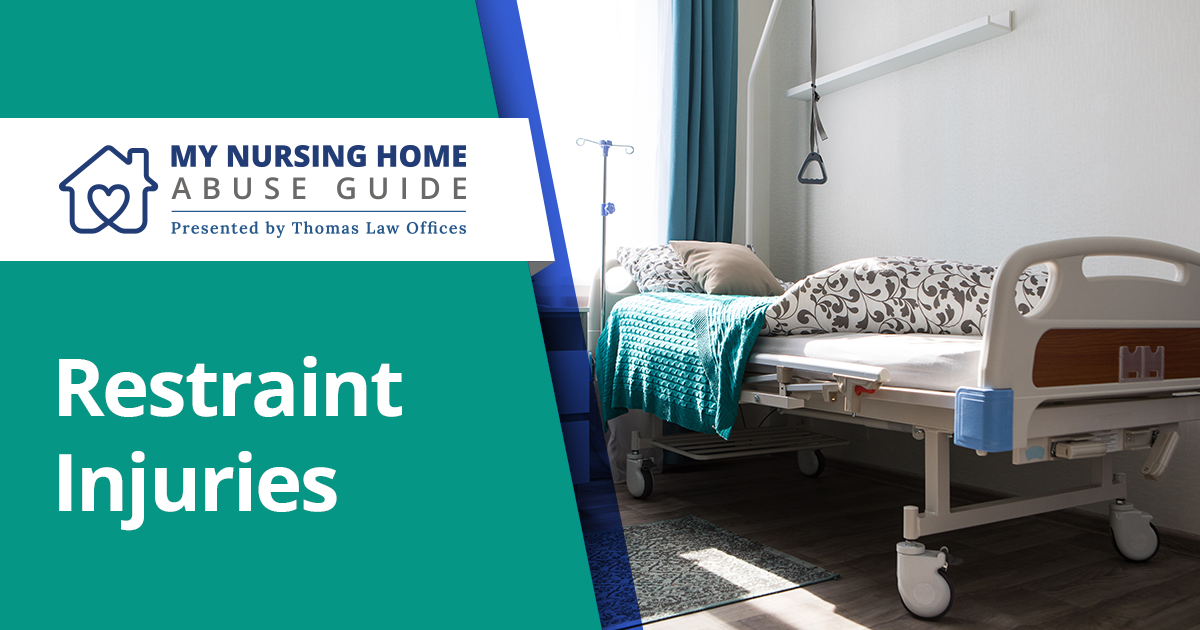Your Guide to Nursing Home Abuse & Prevention
Millions of elderly adults live in nursing home facilities.
Every one of them deserves to feel safe, protected, and respected.
Millions of elderly adults live in nursing home facilities.
Every one of them deserves to feel safe, protected, and respected.

Bed restraints are commonly used in nursing homes. These pieces of equipment limit a patient’s movement to prevent causing harm to themselves or others.
However, when they are inappropriately used, they can cause physical and psychological harm to nursing home residents. Some of these injuries can be an indicator that nursing home abuse has occurred in the facility.
Sometimes, bed restraints are required to make sure the patient stays safe. However, these devices should only be used under close supervision.
Unfortunately, there have been instances where patients were restrained in a bed and left for hours on their own. Often, these nursing homes may have a lack of staff or training to handle these individuals.
In some cases, these restraints are used as a form of punishment.
No matter the situation, bed restraints should never be used in an inappropriate manner that causes harm to a resident. In these cases, it could be a major sign of nursing home abuse.
Getting an injury in a nursing home is not uncommon. But when there are unexplained injuries or significant mental health decline, it should be a cause for concern.
On the physical side, many of these bed restraint injuries occur around the wrists, necks, or ankles.
Injuries can also lead to major emotional problems as well. If you are worried about a loved one, here are some of the types of injuries experienced by nursing home residents.
Skin damage is one of the most common consequences associated with bed restraints. Often, you may see these injuries develop as pressure sores or ulcers. When there is prolonged pressure applied to the skin, then damage can occur.
You can usually find these abrasions on the wrists, arms, ankles, and legs. Most of the time, skin damage just happens to the epidermis.
However, some injuries can develop into deeper wounds that can damage the muscles and tendons.
When bed restraints are improperly used, they can result in severe injuries. Sometimes, the restraints are applied too tightly or become entangled around a patient’s neck. In that case, it can cut off their air supply, leading to significant harm.
These situations can be life-threatening and require immediate medical attention. Signs of strangulation can include ligatures around the neck, face, or other parts of the head.
Physical injuries can result from the use of bed restraints. Often, they happen when a patient attempts to escape from the restraints. In their struggle, they may fall from the bed or hit against the side rails, which can lead to fractures and bruises.
These injuries can be dangerous for elderly patients, who may already have weakened bones due to osteoporosis or other health concerns.
The use of bed restraints in nursing homes can lead to psychological injuries. Being restrained can be humiliating for residents, which can lead to a sense of lost dignity. Residents may feel that their personal boundaries are being violated.
This loss of independence can lead to feelings of helplessness, affecting the resident’s self-esteem and self-worth.
That feeling of being trapped, combined with the lack of control over one’s movements, can also create a state of chronic stress. According to the Mayo Clinic, chronic stress is a known risk factor for depression and anxiety disorders.
Residents may experience persistent feelings of sadness, loss of interest in activities they once enjoyed, and constant worry or fear.
In some cases, the trauma associated with the use of restraints can be so severe that it develops into post-traumatic stress disorder (PTSD).
This mental health condition is triggered by experiencing or witnessing a terrifying event. Residents may relive the experience of being restrained through intrusive memories or nightmares. As a result, they can experience problems in day-to-day life.
If skin damage is not treated promptly, it can become infected. These infections can affect not only the skin but also the underlying tissues and can spread to the bloodstream, a condition known as sepsis.
Sepsis can cause tissue damage, organ failure, and even death.
Untreated fractures often affect the muscles and bones. Many times, it can impair a person’s mobility and quality of life. In extreme cases, improper use of restraints can lead to fatal injuries such as strangulation and asphyxiation, when restraints become entangled around the patient’s neck, cutting off their air supply.
The use of bed restraints can serve a purpose in certain situations. However, in a nursing home setting, it can also be a major indicator of abuse.
Recognizing these injuries can help you determine if your loved one has suffered from inappropriate bed restraint use. For further guidance on the next steps to take, please contact us today.
This website was created and is maintained by the legal team at Thomas Law Offices. Our attorneys are experienced in a wide variety of nursing home abuse and neglect cases and represent clients on a nationwide level. Call us or fill out the form to the right to tell us about your potential case. We will get back to you as quickly as possible.
866-351-2504